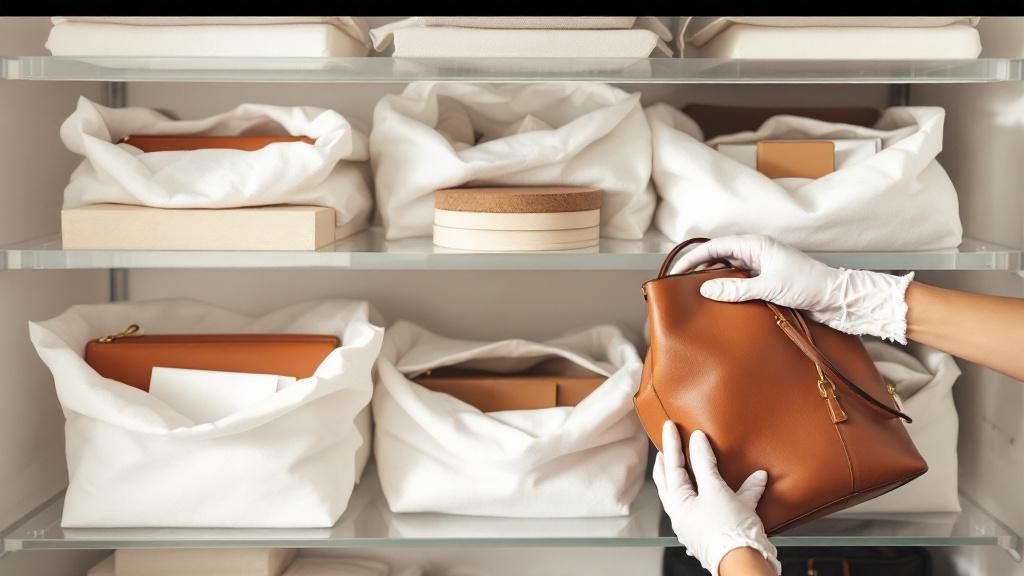Unlocking the Secrets to Preserving Your Precious Handbags
Designer handbags are investments worth protecting. Proper storage is key to maintaining their value and pristine condition. This guide provides six actionable methods to store your designer bags effectively, covering everything from DIY solutions to advanced storage systems. Discover the best way to store designer bags and keep them looking their best.
Knowing the best way to store designer bags is crucial for several reasons:
- Preservation of Value: Proper storage prevents damage, ensuring your bags retain their resale value.
- Maintaining Appearance: Correct techniques prevent fading, cracking, and other wear-and-tear.
- Extending Lifespan: Good storage practices protect your bags from premature ageing.
This listicle reveals six expert-backed methods for storing your designer bags:
- Stuffing with Acid-Free Tissue Paper
- Dust Bag Protection System
- Climate-Controlled Environment Storage
- Proper Positioning and Orientation
- Compartmentalized Storage Systems
- Regular Maintenance and Inspection Schedule
Each tip provides specific, actionable steps to safeguard your collection, whether you own a single prized bag or a curated wardrobe of luxury handbags. Learn how to keep your investment in top condition and enjoy your designer bags for years to come.
1. Stuffing with Acid-Free Tissue Paper
Preserving the pristine condition of your designer handbags requires a thoughtful approach to storage. One of the best ways to store designer bags and maintain their shape and structure is by stuffing them with acid-free tissue paper. This technique prevents creasing, sagging, and other structural damage that can occur when bags are stored empty or compressed. The acid-free nature of the tissue paper is crucial. It safeguards against chemical reactions that can damage delicate leathers and fabrics over time. This makes it a cornerstone of luxury handbag care.
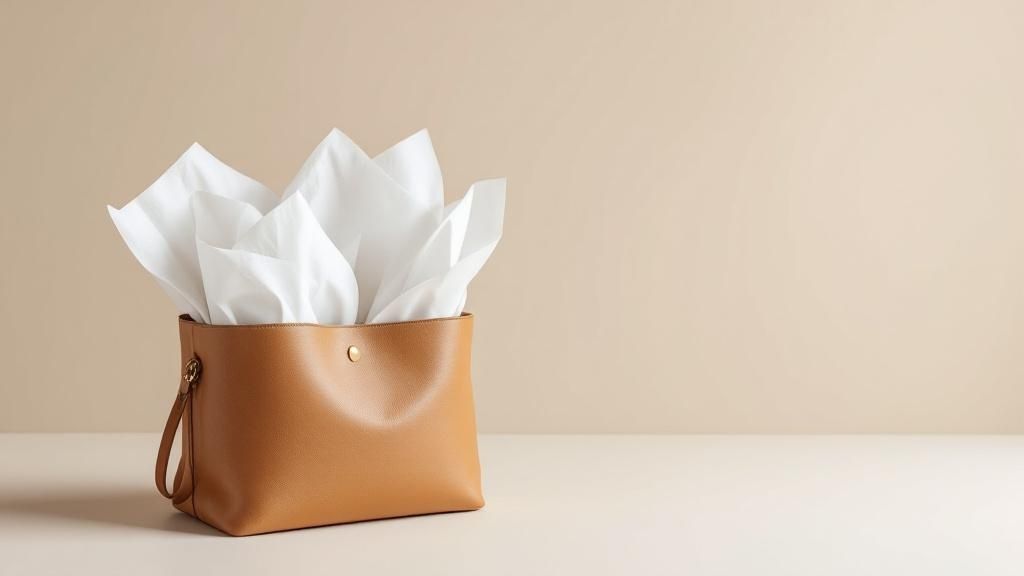
Why Acid-Free Tissue Paper is Essential
Standard tissue paper often contains acids and lignins that can discolour and deteriorate luxury materials. Acid-free tissue paper, however, is specifically treated to neutralize these harmful substances, ensuring the longevity and vibrancy of your handbags. This method is a popular choice amongst museum conservation departments, luxury consignment stores like The RealReal, and professional wardrobe stylists. It underscores its effectiveness as one of the best ways to store designer bags.
Examples of Effective Implementation
The benefits of this technique are evident across various designer bag styles. Imagine a Hermès Birkin, renowned for its structured silhouette. Stuffing with acid-free tissue paper helps maintain its iconic shape. Similarly, the puffy texture of a Chanel quilted bag is preserved, preventing the quilting from flattening. Even the corners of a Louis Vuitton canvas bag benefit, avoiding unsightly creasing that can detract from its elegance.
Actionable Tips for Optimal Results
- Use Unbleached, Acid-Free Tissue Paper: Opt for unbleached tissue paper to further minimise the risk of chemical reactions with your bags.
- Stuff Gently, Avoid Overstretching: Fill the bag gently, ensuring you don't overstuff and stretch the material. Distribute the tissue paper evenly throughout the interior.
- Replace Tissue Paper Every 6-12 Months: Regularly replacing the tissue paper maintains its effectiveness in absorbing moisture and preventing odours. This also ensures that any residual acids, even in acid-free paper, are minimized over time.
- Fill All Compartments and Pockets: Don't just fill the main compartment. Stuff all pockets and compartments to maintain the bag's complete shape and prevent internal creasing.
When and Why to Use This Approach
This method is ideal for long-term storage or when you want to maintain the shape of structured bags. It’s particularly beneficial in humid climates where bags are more susceptible to losing their shape and developing mildew. By using acid-free tissue paper, you're investing in the long-term preservation of your designer handbags, keeping them looking their best and upholding their value. This technique truly stands out as one of the best ways to store designer bags, ensuring they remain in pristine condition for years to come.
2. Dust Bag Protection System
Protecting your designer handbags from the elements is a crucial aspect of luxury handbag care. One of the best ways to store designer bags and shield them from dust, light exposure, and minor scratches is by utilising a dust bag protection system. This method involves storing each bag individually in its protective cloth covering, often referred to as a sleeper bag, while maintaining accessibility for regular use. This simple yet effective strategy safeguards your investment, ensuring your bags retain their pristine condition.
Why Dust Bags are Essential
Dust bags act as a barrier against environmental factors that can compromise the quality of your handbags. Dust accumulation can dull the finish of leather and fabrics, while light exposure can lead to fading and discolouration. The soft fabric of the dust bag also protects against minor scratches that can occur during storage or transport. This makes dust bags a fundamental tool in preserving the beauty and value of your collection.
Examples of Effective Implementation
Many luxury brands understand the importance of dust bag protection. Hermès, for example, provides its iconic orange dust bags, which have become synonymous with the brand and even contribute to resale value. Gucci's signature dust bags not only protect the bags but also help prevent colour bleeding between items. Prada’s nylon dust bags, often matching the brand's signature materials, offer robust protection and complement their technical aesthetic.
Actionable Tips for Optimal Results
- Always Use Original Dust Bags: When available, use the original dust bags provided by the designer. These are specifically designed to fit the bag perfectly and offer optimal protection.
- Keep Dust Bags Clean and Dry: Regularly clean your dust bags to prevent the transfer of dirt or dust to your handbags. Ensure they are completely dry before use.
- Store Bags Upright in Dust Bags: Whenever possible, store your bags upright in their dust bags to maintain their shape and prevent creasing.
- Consider Purchasing Replacement Dust Bags: If original dust bags are lost or damaged, consider purchasing replacements from authorised dealers. This ensures the quality and fit of the dust bag.
When and Why to Use This Approach
The dust bag protection system is ideal for both short-term and long-term storage. It’s a practical way to protect your bags from everyday wear and tear, as well as from the elements when not in use. This method is especially beneficial in dusty or humid environments, where bags are more susceptible to damage. By consistently using dust bags, you’re taking a proactive step towards preserving your handbags and maintaining their value. This simple practice truly shines as one of the best ways to store designer bags, ensuring they remain in impeccable condition for years to come.
3. Climate-Controlled Environment Storage
Preserving the value and beauty of your designer handbags requires more than just proper placement. It demands a controlled environment. Maintaining optimal temperature and humidity levels is paramount to prevent leather cracking, mold growth, and material degradation. This involves mitigating environmental factors like temperature fluctuations, excessive humidity, and poor air circulation, all of which can damage luxury materials over time. This careful approach is one of the best ways to store designer bags and ensure their longevity.
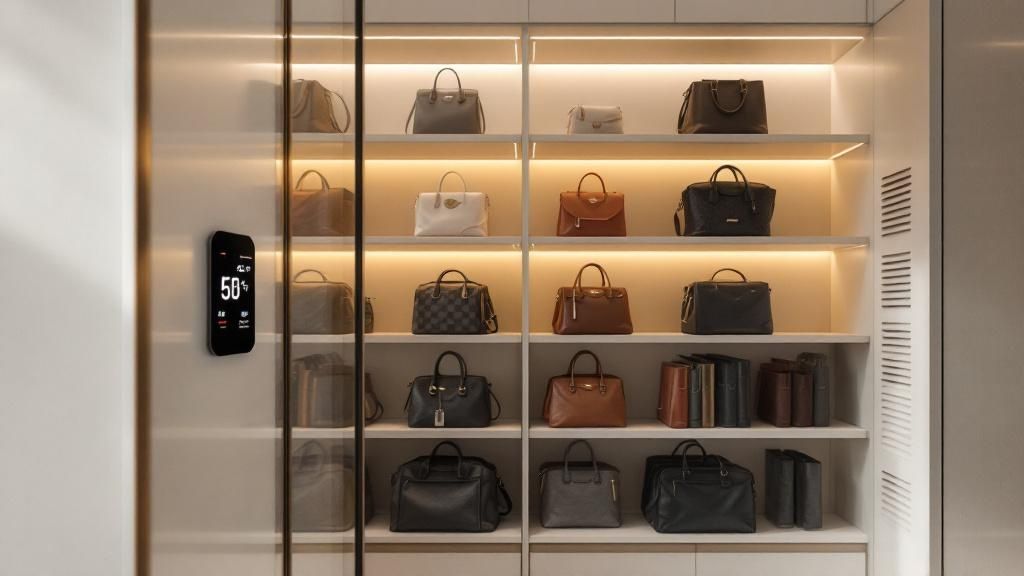
Why Climate Control is Crucial
Leather, especially exotic skins, is highly susceptible to environmental changes. Excessive heat can cause it to dry out and crack, while high humidity can lead to mold and mildew. Controlling these factors is essential for preserving the suppleness and integrity of your bags. For designer bags that require a carefully monitored environment, consider exploring indoor storage solutions from Euro Move Direct. This makes climate control a critical factor among the best ways to store designer bags.
Examples of Effective Implementation
High-end closet systems, like those offered by California Closets, often incorporate climate-control features. Dehumidifiers in basement storage areas can also help regulate humidity levels. Cedar-lined closets with ventilation systems provide a natural, aromatic, and climate-controlled environment, demonstrating the various ways to achieve effective climate control.
Actionable Tips for Optimal Results
- Use a Hygrometer: Monitor humidity levels within your storage space. The ideal range is typically between 40% and 55%.
- Avoid Extremes: Avoid storing bags in attics or basements without climate control, as these areas are prone to extreme temperature fluctuations and humidity.
- Silica Gel Packets: Consider using silica gel packets inside your bags for additional moisture absorption. These small packets help to draw out excess moisture and prevent mildew.
- Proper Ventilation: Ensure proper ventilation to prevent stagnant air, which can contribute to mold growth and unpleasant odours.
When and Why to Use This Approach
This method is essential for long-term storage, especially in regions with fluctuating climates or high humidity. It's particularly beneficial for exotic leather bags, vintage pieces, and any handbag you consider an investment. Climate-controlled storage is a proactive measure that protects your bags from the damaging effects of the environment.
This commitment to environmental control safeguards your investment, maintaining the quality and value of your collection. It demonstrates a dedication to preservation and highlights one of the best ways to store designer bags, ensuring they remain in pristine condition for years to come. This attention to detail will keep your designer bags looking their best, preserving their value and beauty for years to come.
4. Proper Positioning and Orientation
Preserving the shape and structure of your designer handbags requires more than just proper filling. Strategic positioning and orientation play a vital role in preventing deformation, handle stress, and other structural damage during storage. This method focuses on how bags are placed—whether upright, flat, or hung—based on their construction, material, and design to maintain optimal condition. This careful attention to positioning is a key element in maximizing the lifespan of your luxury investments.
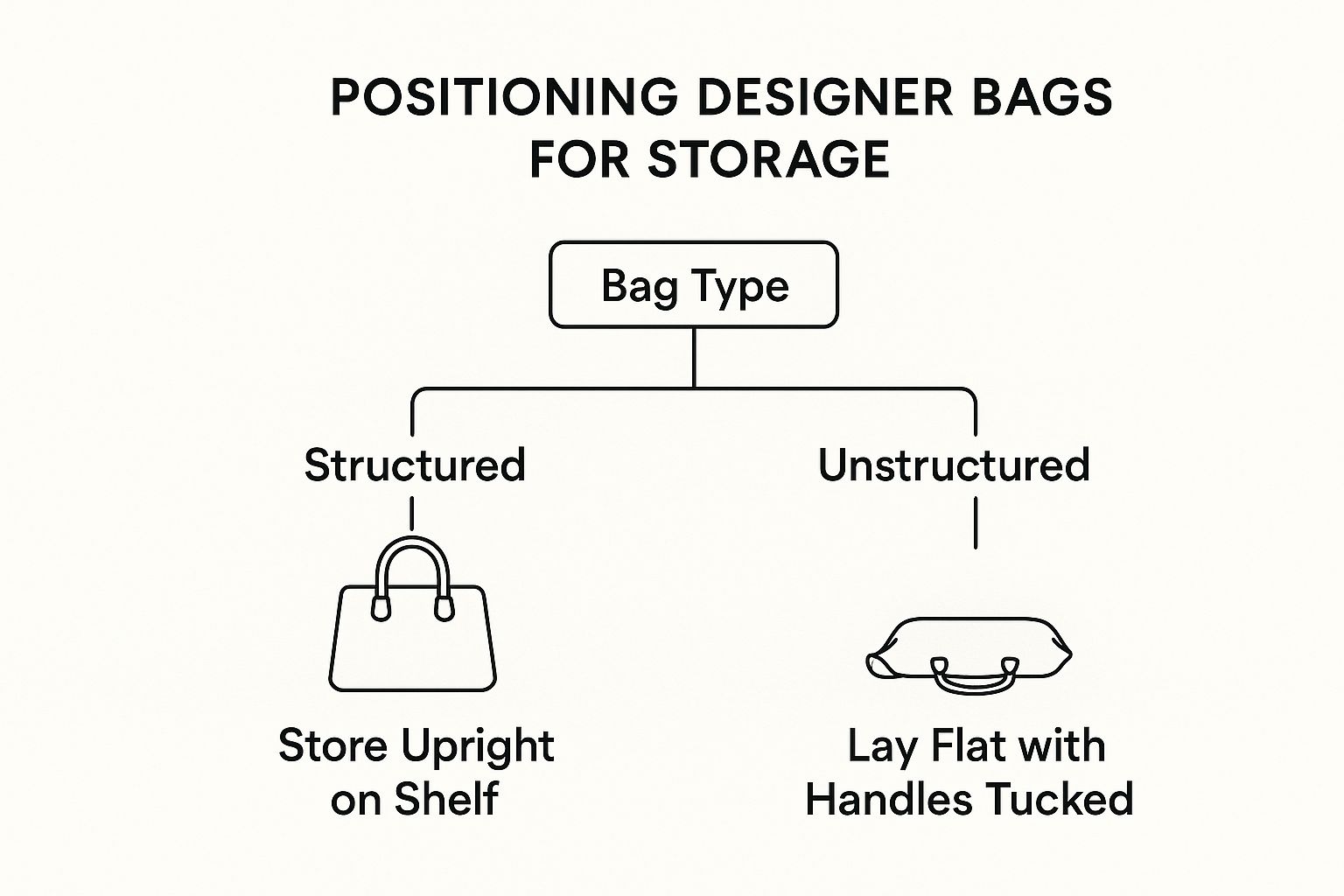
This infographic presents a decision tree to guide you in properly positioning your designer bags for storage. The key decision point is the bag's structure, leading to specific storage recommendations.
The infographic clearly demonstrates that structured bags should be stored upright, while unstructured bags are best stored lying flat. This simple distinction helps maintain the integrity of different bag styles.
Why Proper Positioning Matters
Improper storage can lead to misshapen bags, creased handles, and structural weakening. For example, hanging a heavy bag by its handles for extended periods can stretch the straps and distort the overall shape. Similarly, storing a structured bag on its side can cause it to collapse and lose its form. By understanding the best positioning for each bag type, you can prevent these issues and keep your handbags looking pristine.
Examples of Effective Implementation
Consider a structured Hermès Kelly bag. Storing it upright, like a book on a shelf, with the handles positioned naturally helps maintain its iconic shape. Conversely, a soft leather Bottega Veneta bag is best stored lying flat with the handles tucked inside to prevent stretching and creasing. Even sturdy canvas bags benefit from thoughtful positioning.
Actionable Tips for Optimal Results
- Structured Bags: Store upright like books on a shelf. This helps maintain their shape and prevents the sides from collapsing.
- Soft Leather Bags: Lay them flat with handles tucked inside. This prevents stretching and creasing of the delicate leather.
- Never Hang by Handles: Avoid hanging bags by their handles for extended periods, especially heavier bags. This can stretch the handles and damage the bag's structure.
- Rotate Bag Positions: Periodically rotate the position of your bags to prevent permanent creasing or distortion.
- Dust Bags: Always use dust bags to provide an extra layer of protection against dust, light, and scratches.
When and Why to Use This Approach
This method is crucial for all types of designer bags and is particularly important for long-term storage. For particularly valuable bags, consider dedicated environmental control. You can learn more about this in the guide to climate control self storage from Endless Storage. Proper positioning is an ongoing practice—a small but significant step in preserving the beauty and value of your collection. It is undoubtedly one of the best ways to store designer bags, ensuring they retain their elegant form and remain in excellent condition for years to come.
5. Compartmentalized Storage Systems
Maintaining the value and appearance of your designer handbags requires a strategic storage approach. One of the best ways to store designer bags is by utilizing compartmentalized storage systems. This method involves dedicating individual spaces for each bag, preventing them from touching and potentially causing damage. These separate compartments accommodate varying bag sizes and promote easy access and organization.
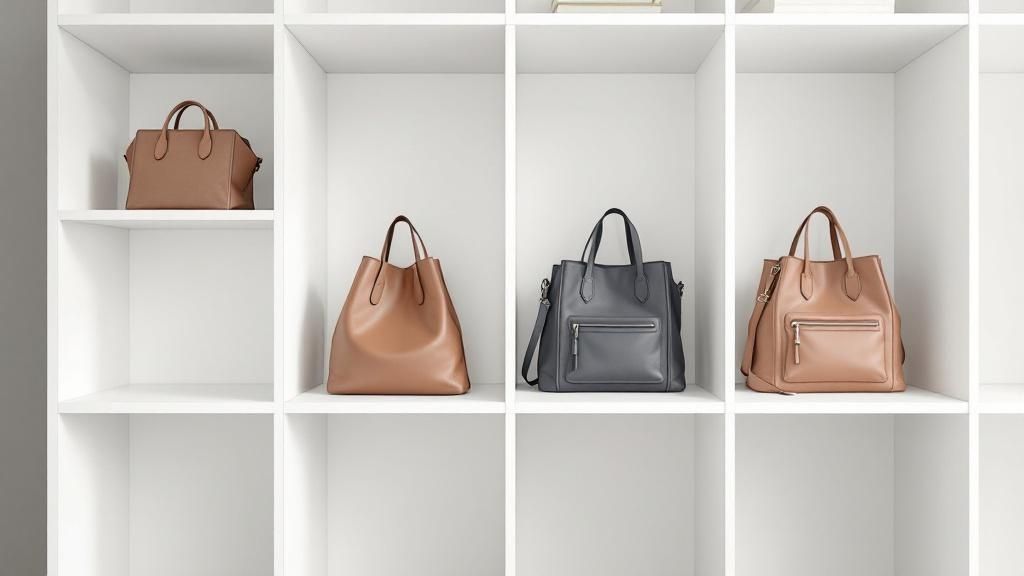
Why Individual Compartments are Crucial
Storing bags together, even when seemingly protected, can lead to scratches, colour transfer, and impressions from hardware. Compartmentalized systems eliminate this risk. Each bag has its own designated space, free from contact with others. This is particularly important for delicate materials like exotic skins or embellished fabrics.
Examples of Effective Implementation
Imagine an IKEA PAX wardrobe customized with inserts perfectly sized for your collection. Visualize a Container Store Elfa system with adjustable shelves and drawers configured for optimal bag storage. Picture a bespoke, boutique-style storage unit, complete with individual compartments and LED lighting. These are just a few examples of how compartmentalization can elevate your handbag storage.
Actionable Tips for Optimal Results
- Measure Your Bags: Before designing your system, meticulously measure your bags to ensure each compartment provides a snug, yet non-restrictive fit.
- Use Adjustable Shelving: Opt for adjustable shelving or dividers for maximum flexibility. This allows you to reconfigure the space as your collection grows and evolves.
- Consider LED Lighting: Integrate LED lighting within your storage to enhance visibility and create a luxurious display.
- Label Compartments: Label each compartment with a photo or description of the bag inside for quick and easy identification.
When and Why to Use This Approach
Compartmentalized storage is ideal for anyone with a growing collection or limited storage space. It’s especially beneficial for those who value organization and easy access to their handbags. This approach is particularly useful in UK homes, where closet space can often be at a premium.
This method is championed by professional closet design companies, luxury fashion retailers, and celebrity stylists. Their endorsement underscores its effectiveness as one of the best ways to store designer bags, safeguarding your investment and maintaining their pristine condition. This method truly stands out as one of the best ways to store designer bags, ensuring they remain in pristine condition for years to come.
6. Regular Maintenance and Inspection Schedule
Preserving the value and beauty of your designer handbags requires more than just proper storage. Implementing a regular maintenance and inspection schedule is crucial for catching potential issues early and ensuring your bags remain in pristine condition for years to come. This proactive approach involves systematically checking your stored bags for signs of damage, wear, and tear, and environmental factors that could compromise their quality. It's a key element of a comprehensive luxury handbag care routine.
Why a Schedule is Essential
A consistent maintenance schedule helps you stay ahead of potential problems. Regular checks allow you to identify issues like loose stitching, discolouration, or hardware malfunctions before they escalate. This proactive approach minimizes the risk of significant damage and costly repairs, preserving the investment you’ve made in your designer handbags. This consistent care is what sets apart a true luxury handbag owner.
Examples of Effective Implementation
Many luxury brands, like Hermès, encourage regular spa treatments for their bags. These professional services include cleaning, conditioning, and minor repairs, helping maintain the bag’s original quality. Professional bag restoration services also emphasize the importance of regular inspections, particularly for vintage bags. Fashion preservation experts advise rotating bags monthly and taking photos to document any changes in condition, creating a visual record of the bag's history.
Actionable Tips for Optimal Results
- Create a Maintenance Calendar: Schedule specific times, perhaps quarterly or bi-annually, to inspect your collection. When considering compartmentalized storage, it's essential to look at ways to maximize your space with smart storage solutions.
- Take Detailed Photos: Document the condition of your bags upon purchase and during each inspection. This visual record helps track any changes and can be invaluable for insurance purposes.
- Keep Records: Maintain a logbook or digital file for each bag, noting cleaning dates, repairs, and any other relevant information.
- Address Issues Immediately: Don't procrastinate on repairs. Addressing minor issues promptly prevents them from becoming major problems.
When and Why to Use This Approach
This method is essential for all designer bags, regardless of their age or material. It’s especially important for bags stored long-term, as they’re more susceptible to environmental factors like dust, humidity, and pests. Regular maintenance preserves your investment, keeps your bags looking their best, and contributes to the overall longevity of your collection. It's arguably the best way to store designer bags, ensuring they remain in top condition and retain their value over time. By incorporating a regular maintenance and inspection schedule, you’re not just storing your bags; you're actively preserving a piece of luxury.
6 Best Designer Bag Storage Methods Comparison
| Method | Implementation Complexity 🔄 | Resource Requirements ⚡ | Expected Outcomes 📊 | Ideal Use Cases 💡 | Key Advantages ⭐ |
|---|---|---|---|---|---|
| Stuffing with Acid-Free Tissue Paper | Moderate 🔄🔄 |
Low – Acid-free tissue paper, periodic replacement ⚡⚡ |
Maintains shape and prevents creasing 📊📊📊 |
Long-term storage for structured or soft bags | Preserves shape and prevents chemical damage |
| Dust Bag Protection System | Low 🔄 |
Low – Dust bags, usually included or purchasable ⚡⚡⚡ |
Protects from dust, light, minor scratches 📊📊 |
Day-to-day storage, frequent use, dust protection | Easy, affordable, maintains resale value |
| Climate-Controlled Environment Storage | High 🔄🔄🔄 |
High – Climate control equipment and monitoring ⚡ |
Prevents cracking, mold, extends lifespan 📊📊📊📊 |
Valuable collection preservation, extremes in climate | Best for long-term preservation, material protection |
| Proper Positioning and Orientation | Low-Moderate 🔄🔄 |
Low – Knowledge and suitable storage furniture ⚡⚡ |
Prevents deformation and handle stress 📊📊 |
Varied bag types requiring specific handling | Maintains proportions and reduces stress |
| Compartmentalized Storage Systems | Moderate-High 🔄🔄🔄 |
Moderate-High – Custom shelving/furniture ⚡⚡ |
Prevents scratching and color transfer 📊📊📊 |
Large collections needing organization | Protects bags individually, efficient layout |
| Regular Maintenance and Inspection Schedule | Moderate 🔄🔄 |
Moderate – Time for inspections, possible professional care ⚡ |
Early problem detection, preserves condition 📊📊📊 |
Long-term owners aiming to preserve value | Prevents major damage through early care |
Elevating Your Handbag Care Routine
Investing in designer handbags is an investment in craftsmanship, style, and enduring luxury. Preserving their pristine condition requires more than just occasional cleaning; it demands a dedicated approach to storage. This comprehensive guide has explored six key strategies for storing your designer bags: stuffing with acid-free tissue paper, utilizing dust bags, maintaining a climate-controlled environment, ensuring proper positioning, using compartmentalized storage, and adhering to a regular maintenance schedule. By mastering these techniques, you're not simply storing bags; you're safeguarding treasured possessions.
The Value of Proper Storage
The best way to store designer bags isn't just about preventing damage. It's about extending the lifespan of your investments, ensuring they remain beautiful and functional for years to come. Proper storage also contributes to a more organized and aesthetically pleasing closet space, transforming it from a source of clutter into a curated display of your style. Imagine effortlessly selecting the perfect bag for any occasion, knowing each one is impeccably preserved and ready to elevate your ensemble.
Key Takeaways for Long-Term Preservation
- Protection is Paramount: Dust bags and acid-free tissue paper are your first line of defense against dust, moisture, and unwanted creasing.
- Climate Control is Crucial: Temperature and humidity fluctuations can wreak havoc on delicate materials. Prioritize a stable environment for optimal preservation.
- Positioning Matters: Proper orientation and support prevent distortion and maintain the bag's original shape.
- Regular Inspection is Key: Scheduled maintenance and cleaning prevent minor issues from escalating into costly repairs.
Implementing Your Handbag Care Strategy
Start by assessing your current storage situation. Identify areas for improvement and implement the strategies outlined in this guide, one step at a time. Begin with the basics like dust bags and tissue paper, then gradually incorporate more advanced techniques like climate control and compartmentalized storage. Remember, consistency is key. Regular maintenance is far more effective than sporadic deep cleans.
The Long-Term Benefits
By prioritizing proper storage, you're not just protecting your handbags; you're preserving their value. Well-maintained designer bags retain their appeal and can even become cherished heirlooms, passed down through generations. This thoughtful approach to care ensures your investment continues to pay dividends in style and enduring elegance. Beyond the monetary value, you're preserving the memories and emotions associated with each piece, making them more than just accessories – they become a tangible representation of your personal style journey.
Looking to expand your collection or discover new investment pieces? Explore Feinheit FZ LLC (https://thefeinheit.com), a curated online retailer offering a wide selection of authentic designer handbags. Feinheit's commitment to quality and authenticity aligns perfectly with the principles of preserving your luxury investments. They offer free global shipping and exclusive discounts, making it easier than ever to acquire and maintain a stunning collection of designer handbags. Use code LUXE5 or WELCOME10 for subscriber savings and embark on your journey towards accessible luxury.

